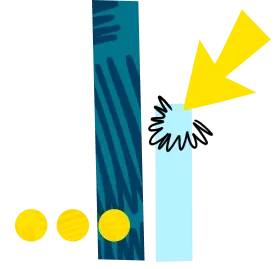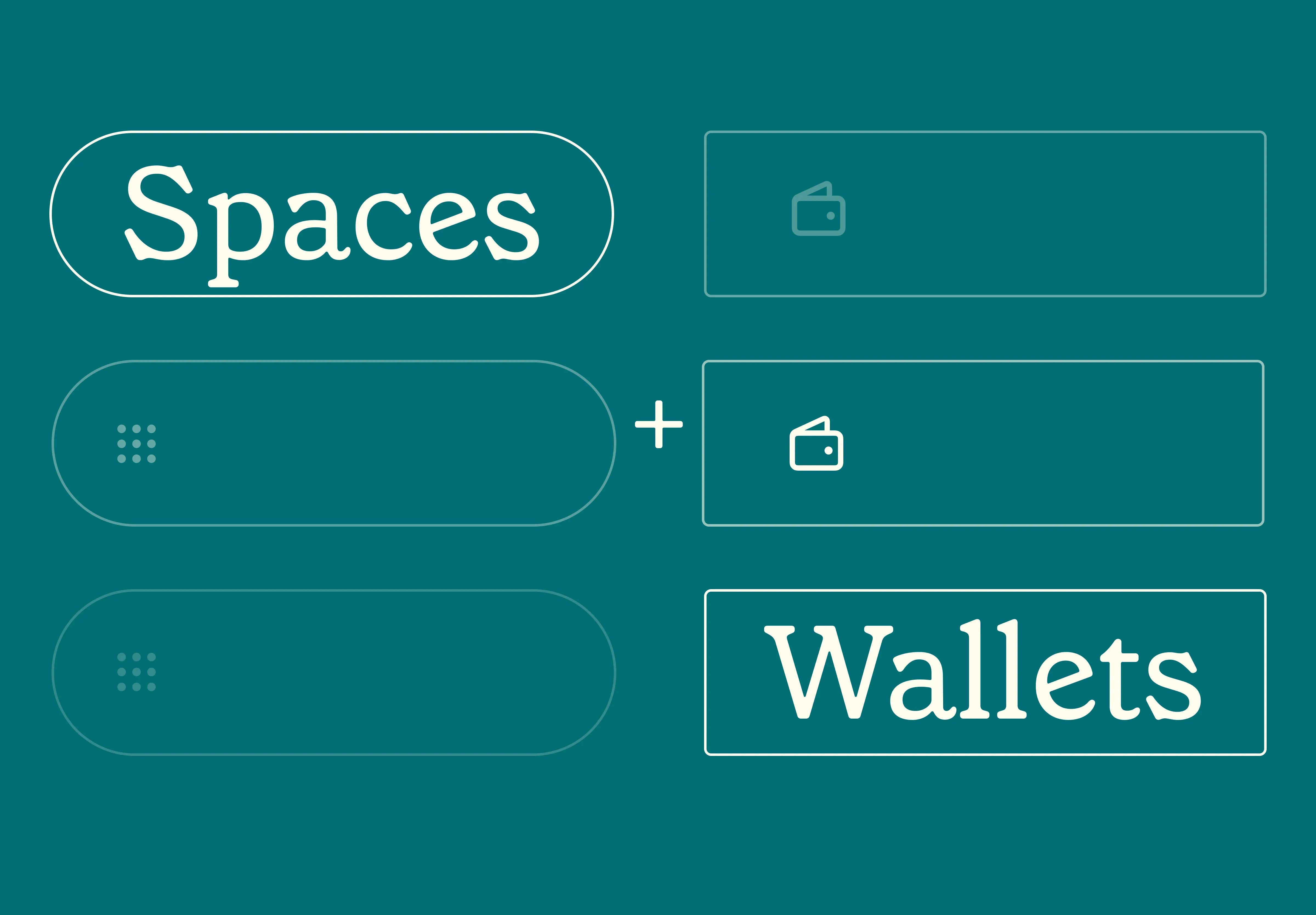14 Nov 2025
|17 min
UX designer career path
Discover the diverse career paths in UX design, from entry-level roles to freelancing and agency ownership, plus salary insights and market trends.

Are you fresh from your studies and eager to land your first UX design role? Or have you recently considered your UX design career progression and are looking to explore other roles in the field?
Whether you’re a novice or a senior UX designer, this article is a must-read if you want to learn more about UX design career paths.
Keep your eyes peeled for stories about career paths, potential UX design specializations, salary figures, and what the future could look like if you want to explore a career in UX design.
What does a UX designer actually do?
A UX designer's day-to-day tasks may include the following:
Gather information through user research to understand what users and the business need.
Create and test prototypes to identify usability issues early in the development process.
Collaborate with other designers, developers, and user researchers to carry out research.
Take part in UX workshops and review sessions, and recommend ways to make future projects even better.
Zack Naylor, the Co-founder/CEO of Aurelius, highlights the importance of user research in generating insights for UX design:
"Generally speaking, UX designers spend a lot of time thinking through interactions with a product and features, creating visual representations for how they should work, and communicating with other teams on how that experience gets made. This comes in the form of user research, problem definition with stakeholders, visual and interaction design, as well as collaboration meetings with cross-functional teams."
Discover what a UX designer does and learn about their day-to-day job from experts in this detailed article: What does a UX designer do?
The UX design career path
One of the great things about a career in UX design is that you can explore multiple paths.
If you want to climb the proverbial career ladder, you can start as a junior or mid-level designer and progress to senior/lead roles managing bigger projects and teams.
Horizontally, you can specialize in areas such as user research, ux interaction design, or user interface (UI) design, with a strong UX focus. This lateral approach allows you to deepen your expertise in UX design while maintaining a broad understanding of the field, making you a valuable asset to any design team.
Alternatively, you can also explore freelancing, consulting, or building your own UX agency from scratch.
It's also worth noting that you don't need to take on management roles to progress in UX design. As one respondent in a study by NN/g about UX careers said:
“Career progression in UX is highly nonlinear and self-driven. I've met too many professionals who've switched to different parts of UX that I'd say it's hard to define what the career path looks like that isn't company specific.”
Now, let's zoom in on the roles for the typical (vertical) and lateral (horizontal) UX designer career paths.
Elevate your research practice
Join over 320,000+ marketers, designers, researchers, and product leaders who use Lyssna to make data-driven decisions.
Vertical career path for UX designers
The vertical career path for UX designers is all about gaining experience and taking on more responsibility:
Junior UX Designer (individual contributor role)
Mid-Level UX Designer (individual contributor role)
Senior/Lead UX Designer (individual contributor + management role)
UX Manager/Director (management role)
Entry-level UX design roles
Entry-level UX designer positions, which are sometimes called junior UX designers, are typically the first step in the career path of most UX designers.
In these roles, you'll work with experienced designers to learn the principles and develop your UX design portfolio. Conducting UX competitor analysis can also help you understand industry standards and improve your design decisions.
Even with limited experience, a well-crafted portfolio that highlights your design thinking process and relevant skills can make you a competitive applicant for entry-level UX designer positions.
Learn from these two designers who successfully landed junior UX design roles after leaving their jobs from unrelated disciplines.
Joyce Christine B. Gonzalez, UI/UX Designer for Microsourcing:
“I initially worked as a technical illustrator before transitioning to UX. During my time at my previous company, they had a few activities for those interested in learning about UX, and I always tried to participate. I also attended events like UX bootcamps to listen to talks and network with fellow aspiring UX designers. Enrolling in both free and paid classes and workshops also helped me gain more experience in UX activities and projects, and learn more about the processes. I slowly started building my portfolio and also volunteered for international non-profit organizations, gaining real-world experience in designing for clients. Having a well-rounded portfolio greatly helped my transition when applying for my first UX job.”
Chris Anthony Torregosa, Senior UX Designer at SPINS:
"Back in college, I pursued a bachelor's degree in seafaring, despite my interest in art and design, because it was my childhood dream to follow in the footsteps of my father, who was a seafarer. I merely regarded design as a hobby, as I didn't know anyone making a living from it.
For four years, I worked as a seafarer on cargo vessels. However, during my third vessel assignment, I began to feel anxious about life at sea. It was then that I realized I couldn't spend the rest of my life on a ship. This prompted me to quit my job and pursue a career in design.
In 2014, I started out as a graphic design consultant armed only with a few portfolios I had created while at sea. I landed my first graphic design job in a tarpaulin printing shop.
To keep myself afloat, I took a lot of odd jobs on the side as I established myself in the design industry. For a while I worked as a real estate agent, an insurance salesman, and a billboard handyman just to make ends meet.
A year later, the surge of websites and mobile applications around that time prompted many graphic designers, myself included, to switch to web and user interface design. This transition brought me numerous clients as a design consultant. During that period, my primary focus was creating aesthetic designs.
In 2018, I got a big break in my career when I landed a job as a UX designer at a printer company. It was there that I learned the fundamental concepts of UX design, and I simply fell in love with it.”
Elevate your research practice
Join over 320,000+ marketers, designers, researchers, and product leaders who use Lyssna to make data-driven decisions.
Mid-level UX designer
As a mid-level UX designer, you’re a go-to problem-solver, bridging the gap between research and execution. At this point, you'll be proficient in design and UX research methods. While still receiving project direction, you might identify problems during research and tackle full product flows that are moderately challenging.
According to Alexsandra Lopes, UX/UI designer at Intmed Software, the difference between a junior and a mid-level designer is mainly autonomy:
"The mid-level designer should be able to make design decisions with a good foundation. This doesn’t mean they won’t need help, but that in critical moments, they will know the best path to take to solve problems, with an awareness of what’s at stake. They are designers who know how to make design decisions."
Senior-level or lead designers
As a senior UX designer, you don't only have exceptional design skills but also a deep understanding of the entire UX design and product development process. You can clearly articulate the reasoning behind your design choices, tailoring your communication style to resonate with different audiences, including senior-level stakeholders.
You go beyond simply conducting user research. You also proactively advocate for its importance, convincing stakeholders and getting buy-in for UX through compelling arguments and research findings.
Finally, your portfolio should showcase instances where your research advocacy led to impactful design decisions.
Charli Cheung, a senior UX designer at Smile CDR Inc, shares what it's like to be a UX designer in a senior role through this video – A day in my Life as a Senior UX Designer.
UX Manager
The role of a UX manager involves leading and motivating the UX team, promoting teamwork, guiding and mentoring junior designers, and managing multiple projects at the same time.
One of your primary responsibilities will be to facilitate effective communication between designers, developers, product managers, and stakeholders. Additionally, you'll be responsible for establishing a robust UX design process within the team to make sure that high-quality deliverables are consistently produced across all projects.
Recommended resource: Transitioning from Individual Contributor (IC) Designer to UX Manager
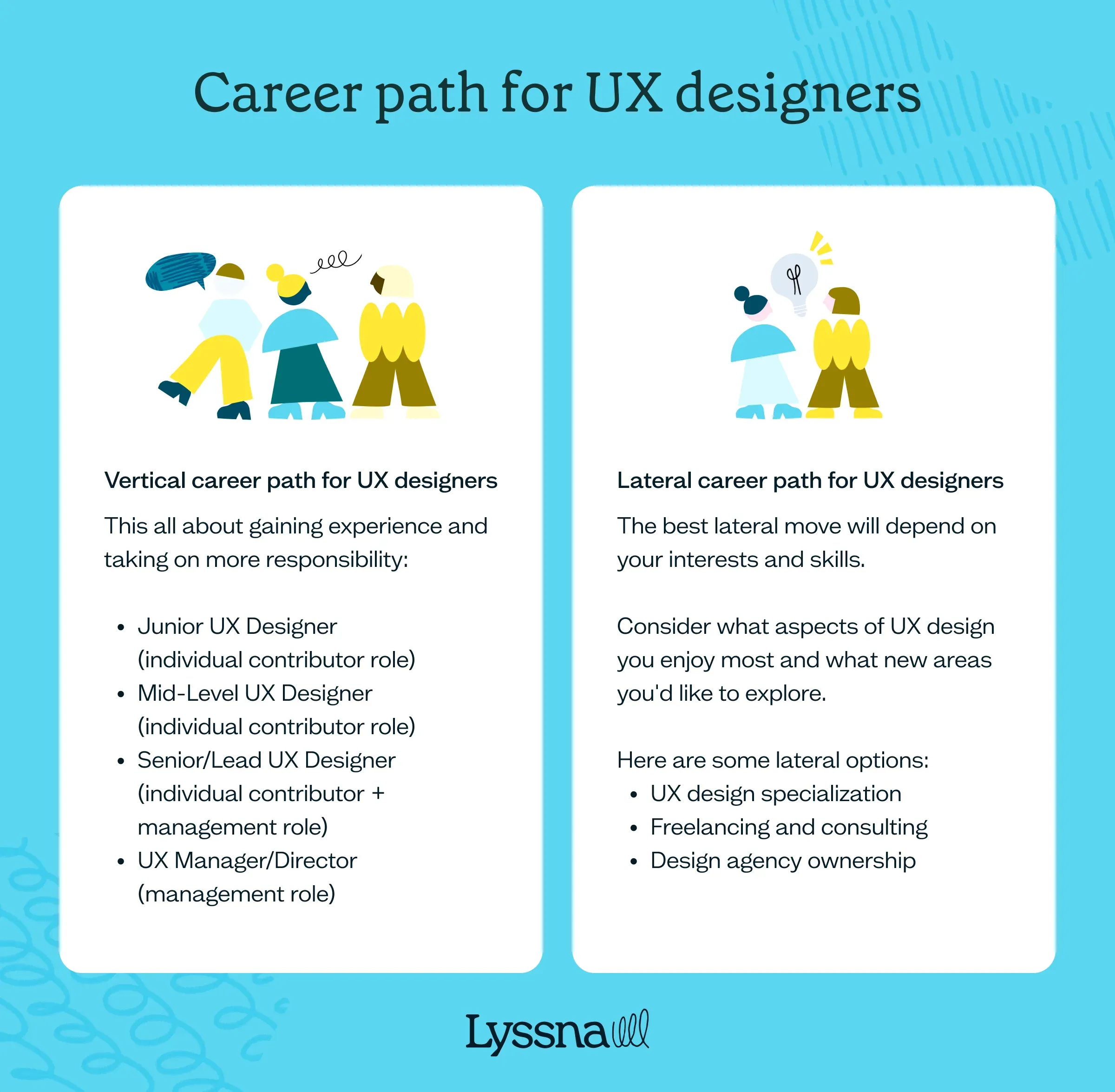
Lateral career path for UX designers
Following this career path, you can explore exciting opportunities beyond traditional senior or lead roles. The best lateral move for you will depend on your interests and skills. Consider what aspects of UX design you enjoy most and what new areas you'd like to explore. Here are some lateral options:
UX design specialization
Freelancing and consulting
Design agency ownership
UX design specialization
A UX designer can potentially take on the following specializations:
UX researcher: This role focuses heavily on the research side of user experience. You'll conduct user interviews, usability testing, and data analysis to inform design decisions.
Content designer or UX writer: In this role, you apply your research findings to craft clear, concise, and user-friendly content within interfaces. If you're curious about the specifics, here's a breakdown of what does a content designer do.
UI designer: Many companies differentiate between UI (user interface) and UX design. As a UI designer, you'll be responsible for creating and enhancing the visual elements and interactivity of the user interface. This includes all the visual aspects that customers or visitors see on their screens when using a website, app, or video game.
Product designer: This role expands your design scope beyond just user experience to encompass the entire product lifecycle. You might be involved in product strategy, user research, and visual design. Learn more about the difference between product design and UX design.
Product manager: UX design and product management go hand-in-hand. With your user-centric approach, you can seamlessly transition into product management, where you oversee the entire product life cycle, from ideation to launch.
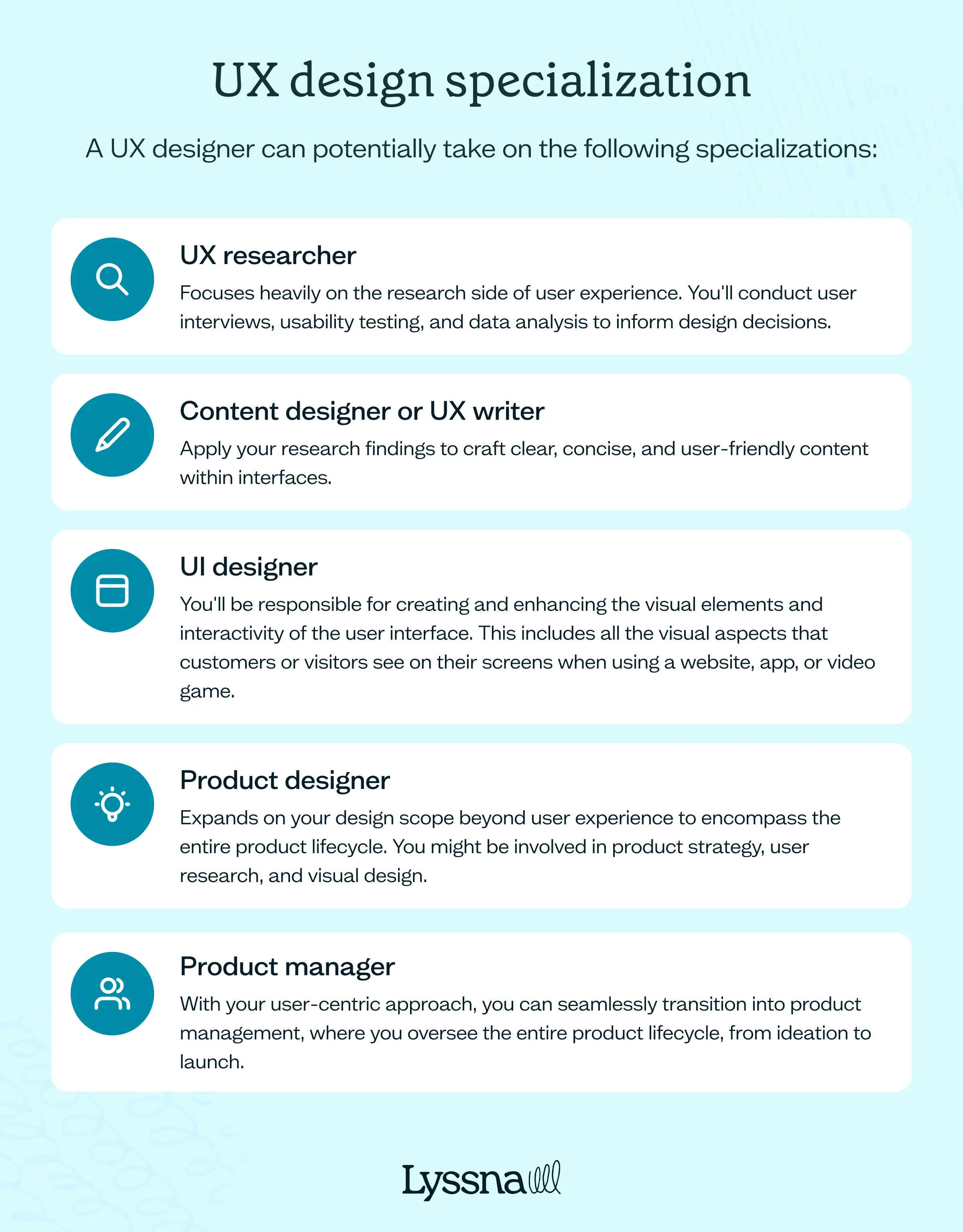
Freelancing and consulting
If you crave autonomy, you can transition to freelance or consulting work. You'll get to work with a diverse range of clients on various projects, but it requires strong business development and client management skills.
Design agency ownership
If you have an entrepreneurial spirit and a passion for building something from the ground up, then starting your own design agency could be the ultimate lateral move.
For this UX design career path, you'll need to go beyond design expertise and develop your business acumen. This includes areas like marketing, sales, finance, and project management.
Francis Alturas is a senior UX designer at GoDaddy, and has gained a wealth of experience throughout his career. He's worked in various roles as an individual contributor, a manager, a consultant, a freelancer, and even as an agency owner and founder. Before joining GoDaddy and moving to Canada, Francis had his own agency and, in this role, he experienced both the highs and lows of being a business owner. He shares:
“Being a founder was my favorite. It has always been a dream of mine as a kid to build a design agency. It felt exciting to get up every day and solve meaningful problems. In a way, I was able to make an impact on our local design community and the world with the products we’ve shipped.
Starting a business is generally exhausting (you work more than being employed) but at the same time, is very fulfilling. Probably the stressful parts would be not having enough capital or having cash flow issues for payroll because of unfavorable market conditions. If you’re more of a maker, having a good co-founder who can handle the financial side of things helps.”
Your go-to user research platform
The best teams use Lyssna so they can deeply understand their audience and move in the right direction — faster.
What can you earn as a UX designer?
UX designer salaries can vary depending on factors like experience, location, education, and even the sector you decide to work in.
As of January 2025, the average salary for a UX designer in the USA is around $123,383/year. Here’s the compensation you can expect at different UX design experience levels:
UX design intern: $85,088
Junior UX designer: $88,581
Mid-career UX designer: $99,101
Senior UX designer: $128,790
UX design manager: $202,783
For a detailed analysis of salaries for UX designers, including factors that affect pay and comparisons by experience, location, education, sector, and related roles, go to our guide on UX designer salaries.
What's the UX design job market like right now?
The UX job market in 2025 is a bit of a mixed bag. There are some challenges due to recent economic trends, but also reasons for optimism.
Job openings are down significantly from their peak in 2022, with UX research being especially impacted. Competition for jobs is high, with many qualified candidates out of work. Hang Xu, a design recruiter, wrote:
“When the layoffs first started around Q2 of 2022, it ‘felt’ and ‘looked’ bad in that suddenly there were a lot of people being laid off while at the same time open roles drastically decreased.
But because the market had so few job seekers at the time, the first folks being laid off could still find new jobs relatively quickly due to a lack of a queue. In other words, there's a delay or lag, and while the worst is technically over, there's now a backlog of qualified candidates the market has to work through.
What does this mean for the individual job seeker? There are more roles open now, but competition has ratcheted up so much that it may take longer to find a job now than a year ago despite seeing more job openings and fewer layoffs each week.”
On the other side of the spectrum, a design hiring manager shared on Reddit that they've been hiring like crazy last year, but with one caveat: they are very picky about their new hires.
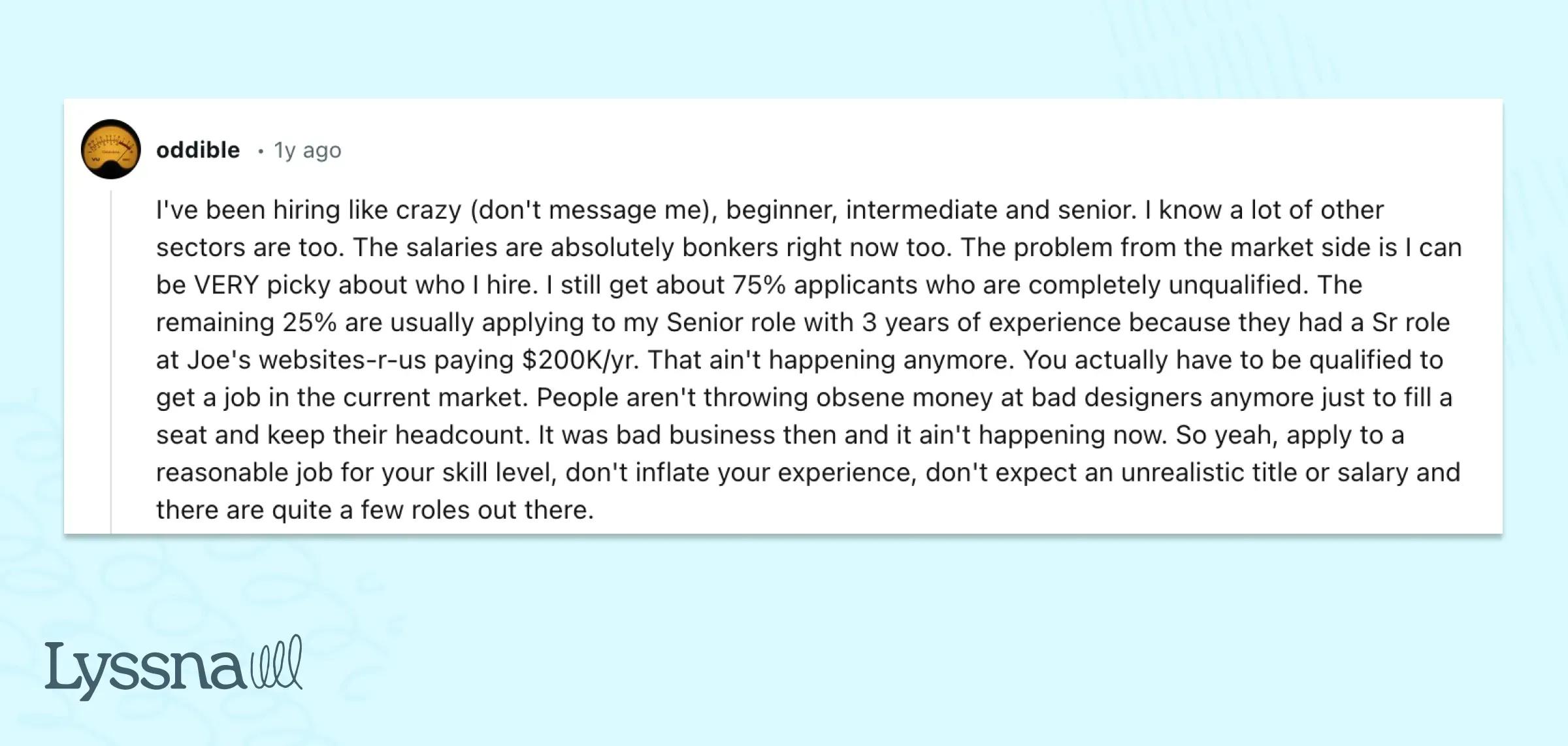
For a more comprehensive take on the current UX design job market, check out Amy Santee's What the heck is going on with the UX job market. She also lays out actionable tips on how UX designers can navigate the current job market.
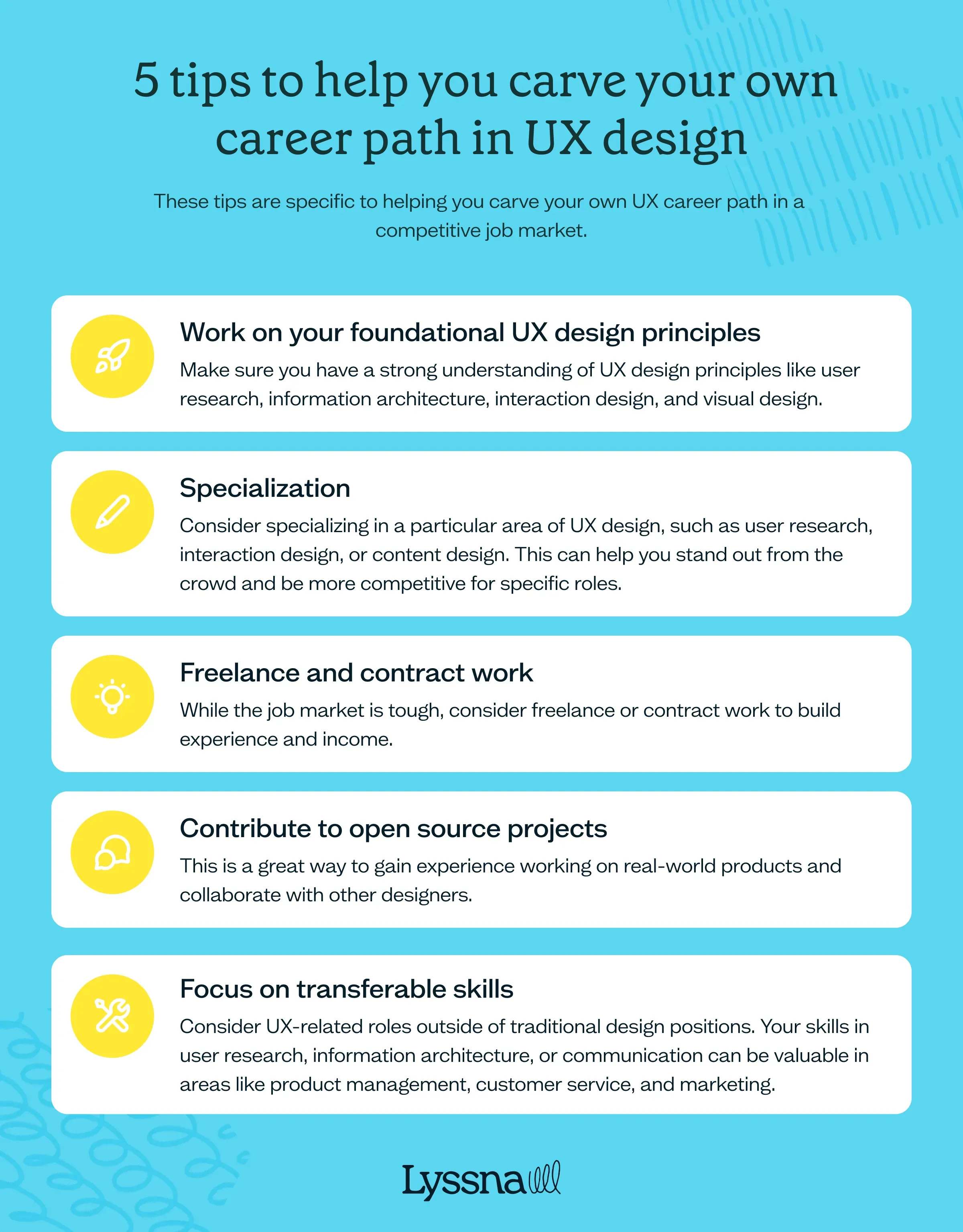
Carving your own UX design career path during a tough job market
Here are some tips to help you carve your own career path in UX design given the current competitive job market.
Work on your foundational UX design principles: Make sure you have a strong understanding of UX design principles like user research, information architecture, interaction design, and visual design. Many online courses, boot camps (be selective of these, though), and even self-study resources are available—including some of the best UX courses to strengthen your foundation.
Specialization: Consider specializing in a particular area of UX design, such as user research, interaction design, or content design. This can help you stand out from the crowd and be more competitive for specific roles.
Freelance and contract work: While the job market is tough, consider freelance or contract work to build experience and income.
Contribute to open source projects: Contribute to open-source UX design projects. This is a great way to gain experience working on real-world products and collaborate with other designers.
Focus on transferable skills: Consider UX-related roles outside of traditional design positions. Your skills in user research, information architecture, or communication can be valuable in areas like product management, customer service, and marketing. It also makes sense to look outside your current niche and shift to other recession-proof industries like healthcare UX design.
You can also take a look at these UX design resources we've created and curated here at Lyssna:
Finally, get some hands-on experience by signing up for Lyssna. You can use Lyssna to research, gather user feedback, and validate your design decisions if you're updating your design portfolio or want to polish up your research skills. Happy learning!
--
Kai has been creating content for healthcare, design, and SaaS brands for over a decade. She also manages content (like a digital librarian of sorts). Hiking in nature, lap swimming, books, tea, and cats are some of her favorite things. Check out her digital nook or connect with her on LinkedIn.
You may also like these articles
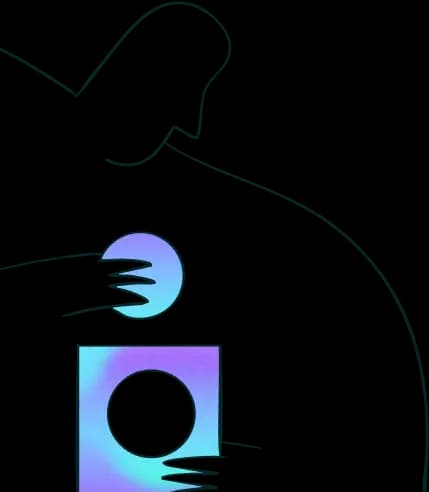
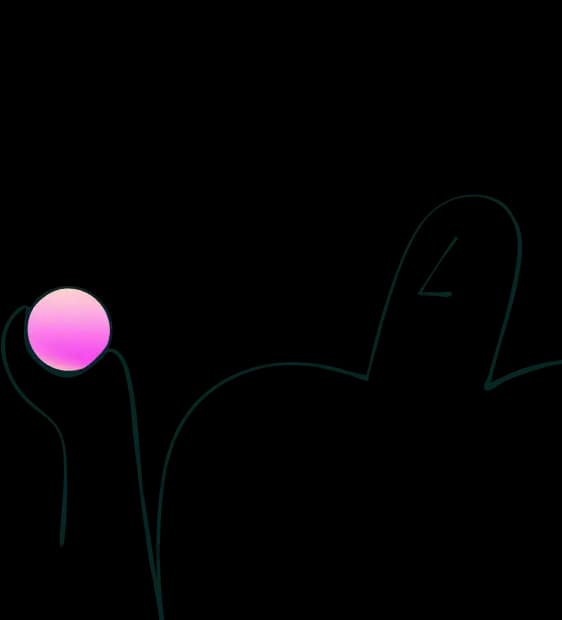
Try for free today
Join over 320,000+ marketers, designers, researchers, and product leaders who use Lyssna to make data-driven decisions.
No credit card required

